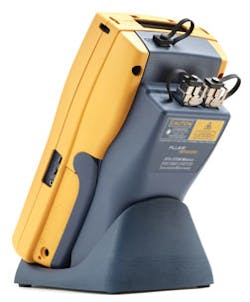It's no secret that electrical technicians are always looking for ways to maximize efficiency and profits by shortening labor hours on a job site. When it comes to fiber-optic testing, a new tool from Everett, Wash.-based Fluke Networks helps them achieve this mission, literally making installation a snap. Introduced to the electrical market this past June, the DTX Compact optical time domain reflectometer (OTDR) snaps onto the company's DTX CableAnalyzer, enabling users to certify both copper and fiber cabling according to industry standards.
“The DTX Compact OTDR module turns an electrical contractor's cable tester into an OTDR, which offers significant benefits,” says Harley Lang, Fluke Network's marketing manager for fiber-optic tools. “For example, contractors are now able to win fiber jobs they may not have been able to attain before. They can also perform jobs using installers who are already on staff., eliminating the need to hire a subcontractor or fiber specialist.”
The DTX Compact OTDR shoots and analyzes traces on singlemode and multimode fiber at four wavelengths. This extended fiber certification — also called Tier 2 — complements the DTX CableAnalyzer's ability to perform basic, or Tier 1, fiber certification.
The result of feedback from contractors, installers, and various customers in the field, Lang says the DTX Compact OTDR is the only product of its kind. “We spent about two-and-a-half years developing the technology, which we took from some of our other products, such as the OptiFiber OTDR,” he says.
According to Lang, several design considerations were taken into account during the OTDR's development. “First, the product needed to be easy to use because contractors must be able to use all of their technicians to do fiber work,” he says. “Our goal was to make it so that every technician can test like a fiber expert.”
The product achieves this objective by allowing installers who are knowledgeable about copper certification to see the familiar DTX interface, test commands, stored setup values, and expert diagnostics — thus shortening the learning curve. Another design consideration was that the device had to be a true OTDR — one that could look at individual events and measure them like a full-blown OTDR. Lastly, the OTDR had to be small enough to fit onto the back of the DTX CableAnalyzer. “Any time you condense a product like that, it presents challenges,” says Lang. “This was a major technical issue we had to address.”
In addition to cable testing, certification, and troubleshooting, the DTX Compact OTDR is compatible with the company's LinkWare results management software. Employing this software, users can save results from both fiber and copper tests in a single file, allowing creation of test reports with basic loss/length results (Tier 1) and extended (Tier 2) fiber certification.
Ronnie Bryant, telecommunications manager for Hi-Tech Electric, an electrical contracting firm with locations in New Orleans, Houston, Dallas, and Pasadena, Calif., has experienced the product's advantages firsthand. “For fiber, we use the DTX Compact OTDR to perform reel tests, fiber certification, and troubleshooting,” he says. “For copper, we use it to perform Cat. 5e and Cat. 6 certifications. Due to the product being so user-friendly, all of my field technicians can be involved in the testing process. I am expecting huge labor savings.”
The DTX CableAnalyzer with Compact OTDR installed measures 8.5 inches by 4.4 inches by 3.6 inches, weighs approximately 3 pounds, and supports many languages.
Priced at around $10,000, the OTDR provides added value for customers who have already invested in the DTX platform. “This is a significant advance to be able to extend a product line like this,” Lang says. “It keeps the product current as well as prevents it from being replaced or becoming obsolete.”
For more information, visit www.flukenetworks.com.
Product Specs
-
Fiber under test: 50/125 µm or 62.5/125 µm multimode; 9/125 µm singlemode
-
Wavelengths: 850 ±20 nm and 1,300 ± 30 nm multimode; 1,310 ± 30nm and 1,550 ± 30 nm singlemode
-
Dynamic range: 850 nm: 24 dB with 200 ns, 1,300 nm: 26 dB with 1 µs multimode; 1,310 nm: 26 dB with 10 µs, 1,550 nm: 24 dB with 10 µs singlemode
-
Max distance range: 850 nm: 6 km, 1,300 nm: 20 km multi mode; 1,310 nm: 20 km, 1,550 nm: 20 km singlemode
About the Author
Stefanie Kure
Content Producer - EC&M
Stefanie Kure is the senior associate editor of EC&M magazine. She holds a Bachelor of Arts degree from the University of Kansas and has more than 20 years of experience in the B2B magazine industry. In addition to EC&M, Stefanie has worked on Transmission & Distribution World magazine, Broadcast Engineering magazine, and Power Electronics Technology magazine.
